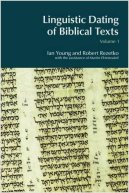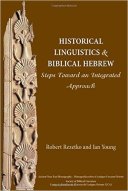It’s an interesting question: Do the linguistic features of Biblical Hebrew allow us to figure out the date of biblical texts? Traditionally, the answer has been ‘yes’. And so Hebrew has been divided into ‘Early Biblical Hebrew’ (‘EBH’ — a.k.a. ‘Standard Biblical Hebrew’, or ‘SBH’) and ‘Late Biblical Hebrew (‘LBH’). As the terms suggest, EBH was viewed as an earlier stage of the language, usually dated to the pre-exilic era (i.e. before 587 BC), while LBH became more prevalent after this time.
Recently, however, a two-volume study, Linguistic Dating of Biblical Texts (London: Equinox, 2008), by Ian Young, Robert Rezetko, and Martin Ehrensvärd, has called this hypothesis into question.

The hypothesis of Young, Rezetko, and Ehrensvärd is that the data usually shown as evidence for a linguistic transition from an early form of Hebrew to a later form can and should be reinterpreted. They argue that instead of being a linear development, both EBH and LBH were concurrent ‘styles’ of Hebrew that coexisted. As a result of this, biblical texts can’t really be dated in the manner previously done. In other words, it is a mistake to think that a text written in EBH is necessarily earlier than a text written in LBH. That would have to be established on other grounds beyond linguistics.
The ramifications of this for our study of Hebrew language and biblical texts are actually quite significant. For starters, if Young, Rezetko, and Ehrensvärd are correct, then we would need to privilege non-linguistic data in determining (or at least trying to determine) the date of particular texts.
But are they correct?
Significant debate has ensued since the publication of LDBT in 2008. Some of it has been carried out in journals and academic conferences. But some of it has been conducted through online forums and blogs. You can find one such exchange being carried out between the authors of LDBT and two critics of their new take, John Cook and Robert Holmstedt. You will find the exchange on the Ancient Hebrew Grammar blog of John Cook and Robert Holmstedt, here:
Cook and Holmstedt disagree with the method and conclusions in LDBT. The discussion is quite heated at times, but that at least makes for interesting reading. You’ll also find John Hobbins over at Ancient Hebrew Poetry weighing critically into the debate.
For my part, let me lay my cards on the table in this debate. I was one of the proof readers for LDBT, and I have to say I found the arguments logically convincing. The critique of the linguistic approach of Avi Hurvitz was, especially, quite persuasive. I agree with Young (who was my PhD supervisor), Rezetko, and Ehrensvärd that too much has been made of linguistic data in the past, and that we cannot really date biblical texts based solely on linguistic grounds. I also agree that building a history of the language based on biblical texts is seriously undermined by the difficulties of thinking about redaction and scribal transmission.
However, there are numerous other questions that arise. If EBH and LBH are not successive stages of the Hebrew language, but rather concurrent ‘styles’, what exactly do they represent? Are they purely dialectal? Was ancient Israel/Judah/Samaria/Yehud a place where diglossia occurred? Is the linguistic divide between LBH and EBH based on geographic, social, or literary grounds—or even other grounds entirely? Do we need new terms to describe these two ‘styles’ of Hebrew?
It will be interesting to see how discussion develops.
 In a hot-off-the-press popular article in Biblical Archaeology Review (September/October 2016), Avi Hurvitz discusses “How Biblical Hebrew Changed.” It is certainly true that Biblical Hebrew evolved over time, but the particulars of how that happened are more complex and debated than Hurvitz acknowledges. The example that he discusses, ʾiggeret and sēfer for “letter,” is a case in point.
In a hot-off-the-press popular article in Biblical Archaeology Review (September/October 2016), Avi Hurvitz discusses “How Biblical Hebrew Changed.” It is certainly true that Biblical Hebrew evolved over time, but the particulars of how that happened are more complex and debated than Hurvitz acknowledges. The example that he discusses, ʾiggeret and sēfer for “letter,” is a case in point.



 Conventional wisdom says that Early Biblical Hebrew (aka Standard Biblical Hebrew or Classical Biblical Hebrew) came first, and then Late Biblical Hebrew. But when you actually analyse the evidence, this view starts to unravel. Ian Young, Robert Rezetko, and Martin Ehrensvärd have argued very convincingly that Early Biblical Hebrew and Late Biblical Hebrew were not linear diachronic developments, but rather contemporaneous styles of Hebrew in antiquity. This means that it’s practically impossible to date a biblical text based solely on linguistic criteria. Their compelling argument can found in their two volume work,
Conventional wisdom says that Early Biblical Hebrew (aka Standard Biblical Hebrew or Classical Biblical Hebrew) came first, and then Late Biblical Hebrew. But when you actually analyse the evidence, this view starts to unravel. Ian Young, Robert Rezetko, and Martin Ehrensvärd have argued very convincingly that Early Biblical Hebrew and Late Biblical Hebrew were not linear diachronic developments, but rather contemporaneous styles of Hebrew in antiquity. This means that it’s practically impossible to date a biblical text based solely on linguistic criteria. Their compelling argument can found in their two volume work,  I have in the past pointed out and recommended the two volumes by Ian Young, Robert Rezetko, and Martin Ehrensvärd, titled Linguistic Dating of Biblical Texts (Equinox, 2008). In these two volumes the authors question the traditional view of the diachronic development of ancient Hebrew that sees the language move from ‘Early Biblical Hebrew’ (EBH) to ‘Late Biblical Hebrew’ (LBH). Instead, they put forward a compelling case that these two forms of Hebrew were actually different styles that existed concurrently.
I have in the past pointed out and recommended the two volumes by Ian Young, Robert Rezetko, and Martin Ehrensvärd, titled Linguistic Dating of Biblical Texts (Equinox, 2008). In these two volumes the authors question the traditional view of the diachronic development of ancient Hebrew that sees the language move from ‘Early Biblical Hebrew’ (EBH) to ‘Late Biblical Hebrew’ (LBH). Instead, they put forward a compelling case that these two forms of Hebrew were actually different styles that existed concurrently.